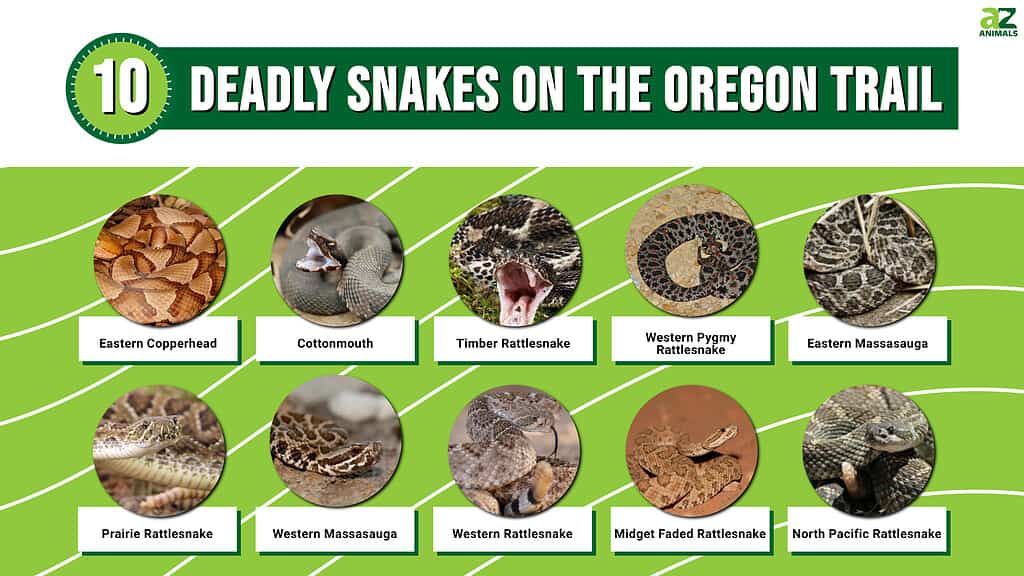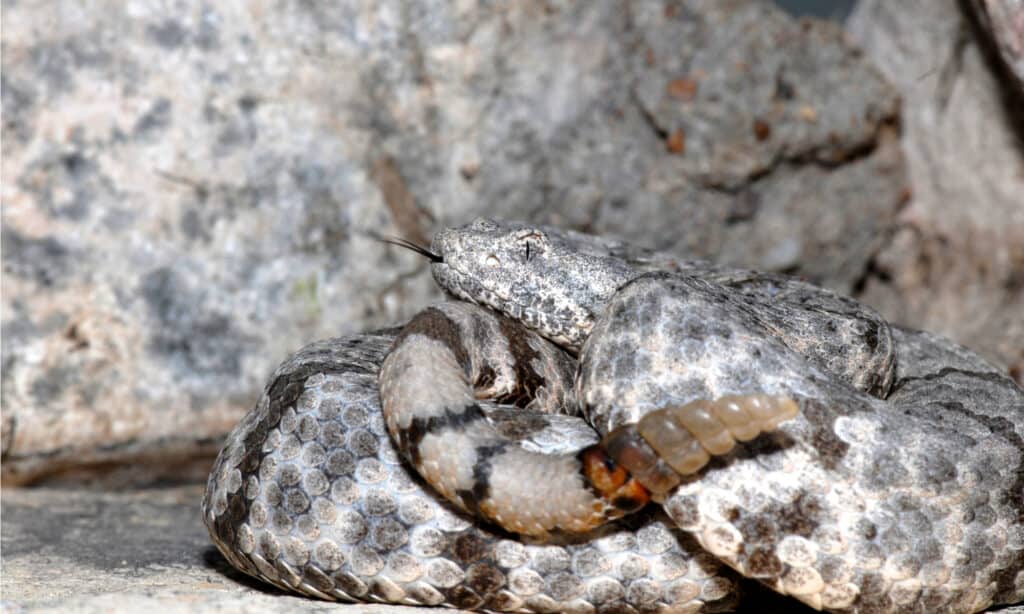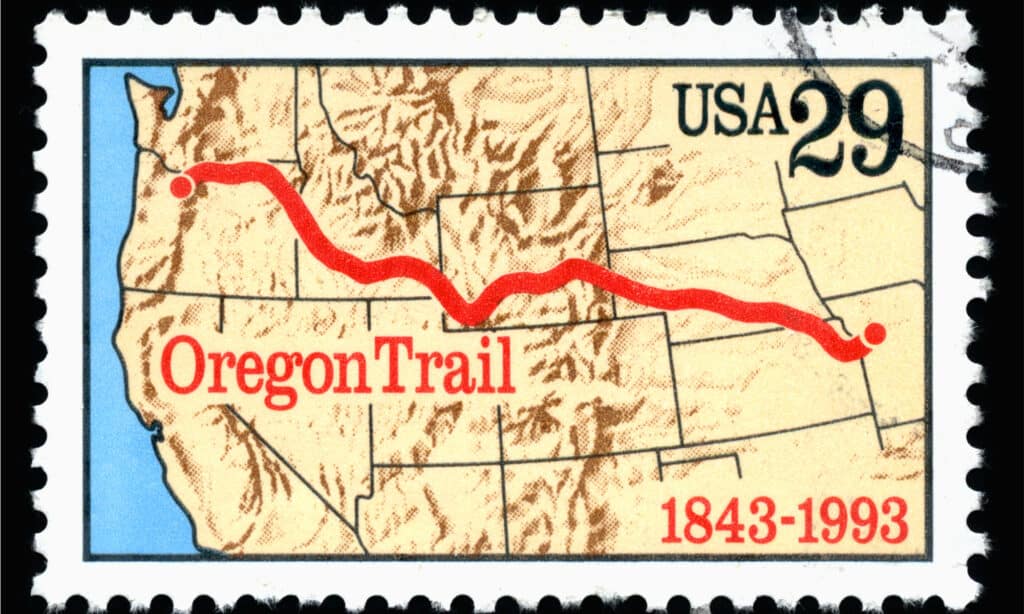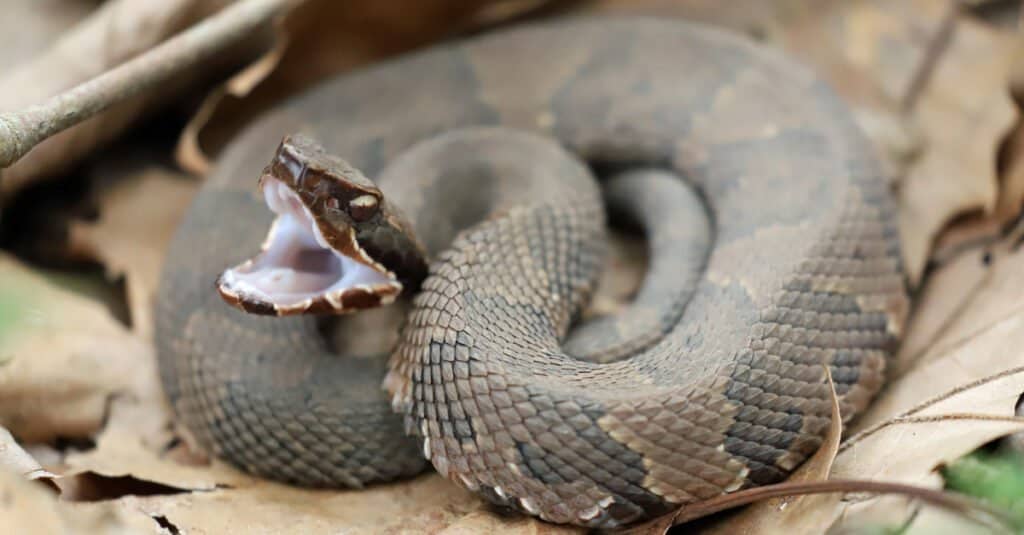The Oregon Trail was a famous wagon trail that connected Missouri to Oregon. The trail was created and used by fur traders. Over time, it was grown and improved but was basically forgotten with the advent of the First Continental Railroad. Eventually, the trail was immortalized by the release of a video game that understated the dangers of traveling along the path. In particular, you could find many deadly snakes on the Oregon Trail, and those animals are the focus of our efforts today. Take a look at all the most powerful venomous snakes that could end someone’s journey on the real Oregon Trail or cause a game over in the game.
The Common Types of Deadly Snakes on the Oregon Trail

Midget faded rattlesnakes aren’t aggressive and try to hide before biting.
©Rusty Dodson/Shutterstock.com
Generally speaking, the United States is home to four distinct genera of venomous snakes. They include coral snakes, rattlesnakes, cottonmouths, and copperheads. The coral snakes have some particularly dangerous venom, but they are not found in the states on the Oregon Trail.
Behind them are rattlesnakes, the largest venomous snakes in the United States. They are numerous, dangerous, and very common. Copperheads and cottonmouths are similar in their level of danger, but neither of them is as common on the trail as rattlesnakes. Nevertheless, they’re animals that people should avoid.
Each of the four types of venomous snakes has several species and subspecies that bring added danger to the situation. We’ll let you know precisely which creatures the travelers had to deal with.
The 10 Deadly Snakes on the Oregon Trail

Copperhead snakes are rare on the Oregon Trail, but they are venomous
©iStock.com/David Kenny
We’ve compiled a list of the venomous snakes that people encountered on the Oregon Trail. Given that the accepted route includes Missouri, Kansas, Nebraska, Wyoming, Idaho, Washington, and Oregon, we’ve created a list of the venomous snakes that lurk in those states.
The 10 venomous snakes on the Oregon Trail are the:
- Eastern copperhead
- Cottonmouth
- Timber rattlesnake
- Western pygmy rattlesnake
- Eastern massasauga rattlesnake
- Prairie rattlesnake
- Western massasauga rattlesnake
- Western rattlesnake
- Midget faded rattlesnake
- Northern Pacific rattlesnake

It’s important to know that some of these species and subspecies are closely related. Essentially, the most common venomous snakes on the Oregon Trail will have rattles on their tail, but they might not always use them.
A State-by-State Analysis of the Deadly Snakes on the Oregon Trail

Rattlesnakes can appear in many colors.
©Rusty Dodson/Shutterstock.com
The Oregon trail was over 2,000 miles in length, running through seven states in total. That put the travelers in contact with a lot of different creatures. Unfortunately, venomous snakes were among those animals that people had to deal with while traveling.
Although snakes were sometimes hunted for food, upwards of a few hundred people died from snakebites from these creatures over the period in which the Oregon Trail was most popular. With that in mind, take a look at the deadly snakes that lurked on the Oregon Trail!

The Oregon Tail cut through Missouri, Kansas, Nebraska, Wyoming, Idaho, Washington, and led into Oregon.
©Tony Baggett/Shutterstock.com
Missouri
The state of Missouri is home to 38 snakes, and 5 of them are venomous. The venomous ones include:
- Eastern copperhead
- Cottonmouth
- Timber rattlesnake
- Western pygmy rattlesnake
- Eastern massasauga rattlesnake
Of all these snakes, the most dangerous one is going to be the timber rattlesnake. Nevertheless, all rattlesnakes are dangerous animals that nobody would want to encounter.
Kansas

Kansas is home to prairie rattlesnakes.
©Nina B/Shutterstock.com
People living in Kansas are fortunate if they are herpetologists! Kansas is home to 42 snakes and 5 of them are venomous. Fortunately, venomous snakes are somewhat rare in the state as you’ll see. Here are the snakes you need to watch out for in this part of the Oregon Trail:
- Cottonmouth
- Eastern copperhead
- Timber rattlesnake
- Prairie rattlesnake
- Western massasauga rattlesnake
Although the timber rattlesnake is skittish, it will bite if threatened or stepped upon. Unfortunately, many of these snakes lurk in grasslands, so it’s hard to see or avoid them. This was probably more of an issue in the early days of the Oregon Trail.
Nebraska
The state of Nebraska is home to many dangerous animals like brown bears, cougars, and coyotes. Also, the area also has four types of venomous snakes. These include:
- Timber rattlesnake
- Prairie rattlesnake
- Copperhead
- Western massasauga rattlesnake
Again, the timber rattlesnake and prairie rattlesnake pose the greatest threats to travelers in this state.
Wyoming
The remote state of Wyoming is beautiful, but it’s not without its share of dangerous animals. Among the deadly animals in Wyoming are grizzly bears, bison, mountain lions, and gray wolves. The venomous snakes on the Oregon Trail that people had to face while traversing this state include:
- The midget faded rattlesnake
- Prairie rattlesnake
The midget faded rattlesnake is a deadly creature, but a rare one. The snake is less than 3ft long and is usually found in the southwestern portion of the state.
Idaho
Garter snakes and gopher snakes are the most common species you’ll find in Idaho. However, of the 12 types of snakes in Idaho, only two are venomous. They are:
- Prairie rattlesnake
- Northern Pacific rattlesnake
These two snakes are somewhat rare, but they blend into grass and fallen leaves very well.
Washington

Western rattlesnakes are found in Eastern Washington.
©Alexander Wong/Shutterstock.com
Washington State is home to many dangerous animals including giant hornets, black widows, and grizzly bears. However, when it comes to venomous snakes there’s just a single snake in Eastern Washington to worry about, the western rattlesnake.
Rattlesnakes are rarely found near human settlements these days, but they could have been stumbled upon by humans back when the Oregon Trail was still operating.
Oregon
Oregon is packed with all sorts of amazing wildlife. However, the only venomous snake that lives in this part of the country is the western rattlesnake.
Interestingly, the number of dangerous species of snakes decreases as one gets closer to Oregon. The travelers were probably very relieved to need to worry only about a single species of venomous snake in the area.
Why Snakes on the Oregon Trail Were Deadly: No Antivenom

Cottonmouth snakes
have a white mouth that is responsible for their name
©KF2017/Shutterstock.com
Roughly 10,000 people are bitten by venomous snakes throughout the United States every year. About five people or fewer die from these bites. Still, 70% of people that are bitten by venomous snakes use some kind of antivenom therapy but survive with moderate side effects.
Without antivenom, the people on the Oregon Trail had few helpful treatments. Sucking out venom wasn’t going to work, and the hemotoxic venom from the snakes would lead to horrible pain and internal bleeding, and possible death.
Sometimes, snakes deliver a dry bite, one without venom. However, if envenomated, people would have terrible difficulty, either dying or surviving with disabilities. Nevertheless, one estimate from a researcher named John David Unruh stated that roughly 200-500 individuals died of miscellaneous deaths on the trail.
Those miscellaneous deaths included things like snakebites, murders, floods, and more. When you consider that disease and fights with Native Americans accounted for about 17,000 deaths, it’s clear that snakebites weren’t a major cause for concern.
Although many people died on the Oregon Trail, the video game version overplayed the hazards of snakebites but left out other forms of death and violence.
Summary of 10 Deadly Snakes on the Oregon Trail
The following chart shows which venomous snake can be found in each state along the Oregon Trail. Obviously, the first three states were the most infested with deadly snakes!
| Name of Snake | Missouri | Kansas | Nebraska | Wyoming | Idaho | Washington | Oregon |
|---|---|---|---|---|---|---|---|
| Eastern Copperhead | X | X | X | ||||
| Cottonmouth | X | X | |||||
| Timber Rattlesnake | X | X | X | ||||
| Western Pygmy Rattlesnake | X | ||||||
| Eastern Massasauga | X | ||||||
| Prairie Rattlesnake | X | X | X | X | |||
| Western Massasauga | X | X | |||||
| Western Rattlesnake | X | X | |||||
| Midget Faded Rattlesnake | X | ||||||
| Northern Pacific Rattlesnake | X |
The photo featured at the top of this post is © Rodolfo Ayala Plata/Shutterstock.com
Discover the "Monster" Snake 5X Bigger than an Anaconda
Every day A-Z Animals sends out some of the most incredible facts in the world from our free newsletter. Want to discover the 10 most beautiful snakes in the world, a "snake island" where you're never more than 3 feet from danger, or a "monster" snake 5X larger than an anaconda? Then sign up right now and you'll start receiving our daily newsletter absolutely free.
Thank you for reading! Have some feedback for us? Contact the AZ Animals editorial team.






